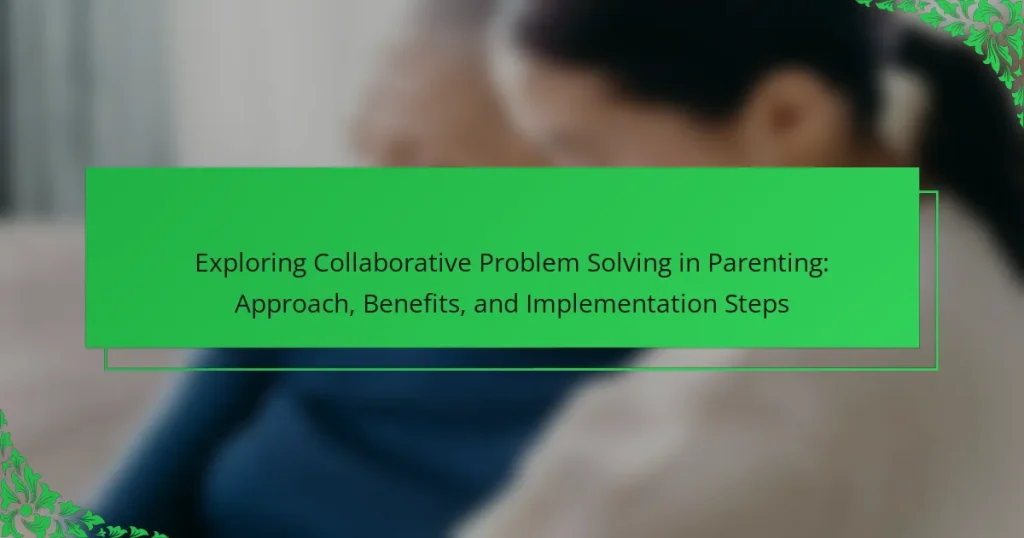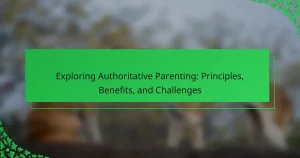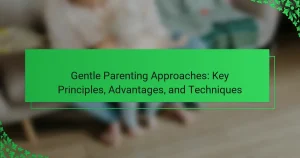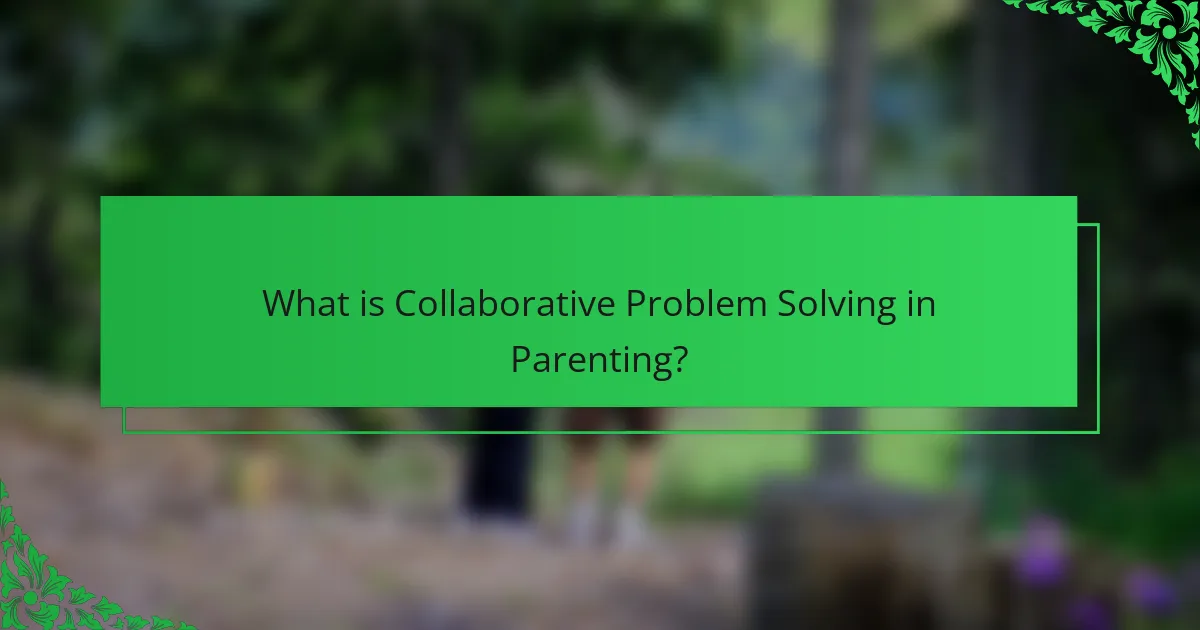
What is Collaborative Problem Solving in Parenting?
Collaborative Problem Solving in Parenting is a method that emphasizes teamwork between parents and children to address behavioral challenges. This approach focuses on understanding the child’s perspective and fostering communication. It encourages parents to engage children in discussions about problems rather than imposing solutions. Research indicates that this method helps build problem-solving skills and strengthens relationships. The Collaborative Problem Solving model was developed by Dr. Ross Greene, who found that it reduces frustration and enhances cooperation. Studies show that children involved in this process exhibit improved emotional regulation and social skills.
How does Collaborative Problem Solving differ from traditional parenting approaches?
Collaborative Problem Solving (CPS) differs from traditional parenting approaches by emphasizing teamwork between parents and children. CPS encourages open dialogue and mutual respect, while traditional methods often rely on authority and discipline. In CPS, parents and children work together to identify problems and develop solutions. This approach nurtures problem-solving skills and emotional intelligence in children. Traditional parenting may prioritize obedience over understanding, which can hinder a child’s ability to navigate challenges independently. Studies show that CPS leads to improved relationships and better behavioral outcomes compared to traditional methods. For instance, research published in the Journal of Child Psychology and Psychiatry indicates that CPS can reduce behavioral issues more effectively than conventional discipline techniques.
What key principles define Collaborative Problem Solving in parenting?
Collaborative Problem Solving in parenting is defined by three key principles: empathy, collaboration, and skill-building. Empathy involves understanding a child’s perspective and emotions. This helps in recognizing the underlying issues behind behaviors. Collaboration emphasizes working together with the child to identify problems and develop solutions. This approach fosters a sense of teamwork. Skill-building focuses on teaching children the skills necessary to handle challenges independently. Research shows that these principles lead to improved behavior and emotional regulation in children. Studies highlight that children who engage in this process show increased problem-solving skills and reduced conflict.
How can Collaborative Problem Solving foster a positive parent-child relationship?
Collaborative Problem Solving fosters a positive parent-child relationship by promoting open communication and mutual respect. This approach encourages children to express their thoughts and feelings. Parents actively listen and validate these emotions, creating a supportive environment. Research shows that when children feel heard, they are more likely to engage positively with their parents. Collaborative Problem Solving also teaches children problem-solving skills. These skills empower children to take responsibility for their actions. As a result, this builds trust and strengthens the bond between parent and child. Studies indicate that families using this method report improved relationships and reduced conflict.
What are the core components of the Collaborative Problem Solving approach?
The core components of the Collaborative Problem Solving (CPS) approach are empathy, collaboration, and skill-building. Empathy involves understanding the child’s perspective and emotions. Collaboration focuses on working together to find solutions to problems. Skill-building aims to teach children the necessary skills to manage their emotions and behaviors effectively. These components are essential for fostering a supportive environment. Research shows that CPS improves relationships and enhances problem-solving abilities in children. The approach is backed by studies indicating its effectiveness in reducing challenging behaviors.
How do empathy and understanding play a role in this approach?
Empathy and understanding are crucial in collaborative problem solving in parenting. They foster open communication between parents and children. Empathy allows parents to recognize and validate their children’s feelings. This validation helps children feel heard and respected. Understanding enables parents to grasp their children’s perspectives. This comprehension leads to more effective problem-solving strategies. Research shows that empathetic parenting improves children’s emotional regulation. A study by Eisenberg et al. (2006) found that empathy in parenting correlates with positive child outcomes. Thus, empathy and understanding enhance the collaborative problem-solving approach in parenting.
What strategies are involved in implementing Collaborative Problem Solving?
Strategies involved in implementing Collaborative Problem Solving include establishing a collaborative relationship, defining the problem together, and brainstorming solutions. A collaborative relationship fosters trust and open communication. Defining the problem involves identifying the specific issues that need addressing. Brainstorming solutions encourages creative thinking and involvement from all parties. Additionally, evaluating the effectiveness of solutions is crucial for ongoing improvement. Implementing these strategies can lead to better outcomes in parenting situations. Research indicates that Collaborative Problem Solving improves conflict resolution skills and strengthens family bonds.
What benefits does Collaborative Problem Solving offer to families?
Collaborative Problem Solving offers several benefits to families. It enhances communication among family members. Improved communication leads to better understanding and cooperation. Families learn to approach conflicts constructively. This method fosters emotional intelligence in both parents and children. Enhanced problem-solving skills are developed through collaboration. Research shows that families using this approach report lower stress levels. Furthermore, it strengthens family bonds and promotes a sense of teamwork. Families become more resilient in facing challenges together.
How can this approach improve communication between parents and children?
This approach can improve communication between parents and children by fostering mutual understanding and respect. Collaborative problem-solving encourages open dialogue. It enables children to express their thoughts and feelings freely. Parents learn to listen actively and validate their children’s perspectives. This method reduces conflicts and promotes cooperative relationships. Research shows that effective communication leads to better emotional regulation in children. According to a study by Greene et al. (2016), children involved in collaborative discussions demonstrate increased problem-solving skills. This creates a supportive environment where both parties feel heard and valued.
What impact does Collaborative Problem Solving have on children’s emotional development?
Collaborative Problem Solving positively impacts children’s emotional development. It fosters emotional regulation by teaching children to express feelings constructively. This approach encourages empathy as children learn to understand others’ perspectives. Children engaged in Collaborative Problem Solving develop better communication skills. They learn to articulate their needs and negotiate effectively. Research shows that children using this method show increased resilience and adaptability. A study by Greene et al. (2004) highlights improvements in emotional intelligence among participants. Overall, Collaborative Problem Solving equips children with essential emotional skills for life.
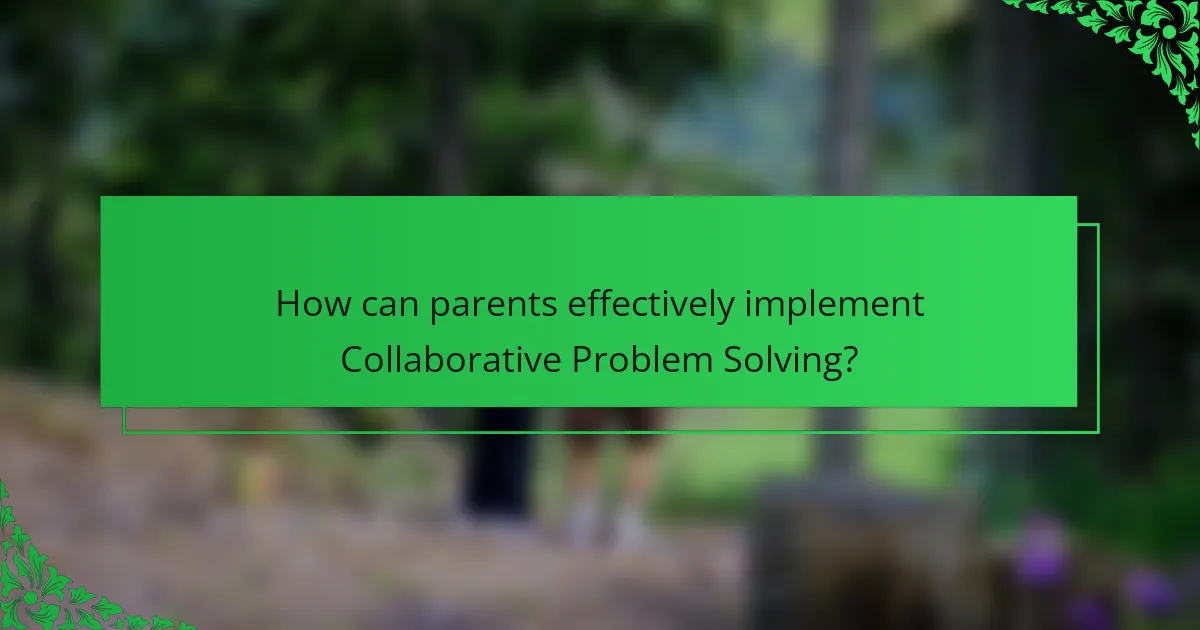
How can parents effectively implement Collaborative Problem Solving?
Parents can effectively implement Collaborative Problem Solving by following a structured approach. First, they should identify the specific problem that needs resolution. Next, parents must engage their child in a discussion about the issue. This involves asking open-ended questions to understand the child’s perspective. Parents should then brainstorm potential solutions together. It is crucial to evaluate each solution’s feasibility and consequences. After agreeing on a solution, parents need to implement it collaboratively. Finally, they should review the outcome together to assess its effectiveness. Research shows that this method enhances communication and strengthens the parent-child relationship.
What initial steps should parents take to start using Collaborative Problem Solving?
Parents should begin using Collaborative Problem Solving by understanding its core principles. They need to recognize that this approach focuses on collaboration rather than traditional discipline. Next, parents should educate themselves about the model through books or workshops. Resources like “The Explosive Child” by Ross Greene provide valuable insights. Parents should also assess their child’s specific challenges and behaviors. Identifying these issues will help tailor the approach effectively. Additionally, establishing a supportive environment is crucial. Parents should encourage open communication and express empathy towards their child’s feelings. Finally, practicing patience is essential as this method requires time to see results.
How can parents assess their current problem-solving strategies?
Parents can assess their current problem-solving strategies by reflecting on past challenges. They should identify specific situations where they faced difficulties. Analyzing the outcomes of their solutions provides insights into effectiveness. Parents can also seek feedback from children about their approaches. Observing children’s reactions can highlight the impact of strategies used. Additionally, keeping a journal of problem-solving experiences can reveal patterns. Reviewing these entries helps in recognizing strengths and weaknesses. Utilizing resources, such as parenting workshops, can further enhance assessment. These methods collectively help parents improve their problem-solving skills.
What resources are available to support parents in this approach?
Resources available to support parents in collaborative problem solving include books, workshops, and online courses. Books like “The Explosive Child” by Ross Greene provide insights and strategies. Workshops often offered by local parenting organizations teach practical skills. Online courses, such as those on platforms like Coursera, cover collaborative problem-solving techniques. Additionally, parenting forums and support groups facilitate peer-to-peer sharing of experiences. These resources enhance understanding and application of the approach.
What challenges might parents face when adopting this approach?
Parents may face communication difficulties when adopting collaborative problem solving. Misunderstandings can arise between parents and children. This approach requires clear expression of thoughts and feelings. Parents may struggle with emotional regulation during conflicts. Managing their own emotions is crucial for effective collaboration. Time constraints can also pose a challenge. Finding time for discussions and problem-solving sessions can be difficult. Additionally, parents may encounter resistance from children. Children might be reluctant to engage in this process. Lastly, inconsistent application of the approach can undermine its effectiveness. Consistency is key for successful implementation.
How can parents overcome resistance from children during the implementation process?
Parents can overcome resistance from children by engaging them in the decision-making process. This approach fosters a sense of ownership and reduces opposition. Involving children in discussions about changes encourages their input and addresses their concerns. Setting clear expectations and explaining the reasons behind decisions can also help. Children are more likely to cooperate when they understand the purpose. Consistent communication reinforces trust and helps children feel valued. Additionally, using positive reinforcement can motivate children to embrace new ideas. Research indicates that collaborative approaches lead to better compliance and emotional outcomes for children.
What common misconceptions about Collaborative Problem Solving should parents be aware of?
A common misconception about Collaborative Problem Solving (CPS) is that it is merely a permissive approach to parenting. In reality, CPS emphasizes structure and guidance while fostering collaboration. Another misconception is that CPS lacks effectiveness in addressing serious behavioral issues. Research shows that CPS can significantly reduce challenging behaviors when implemented correctly. Many parents believe CPS is time-consuming. However, it often leads to quicker resolutions in the long term. Additionally, some think CPS requires complete agreement between parent and child. In truth, CPS focuses on understanding and finding solutions rather than consensus. These misconceptions can hinder the successful application of CPS in parenting.
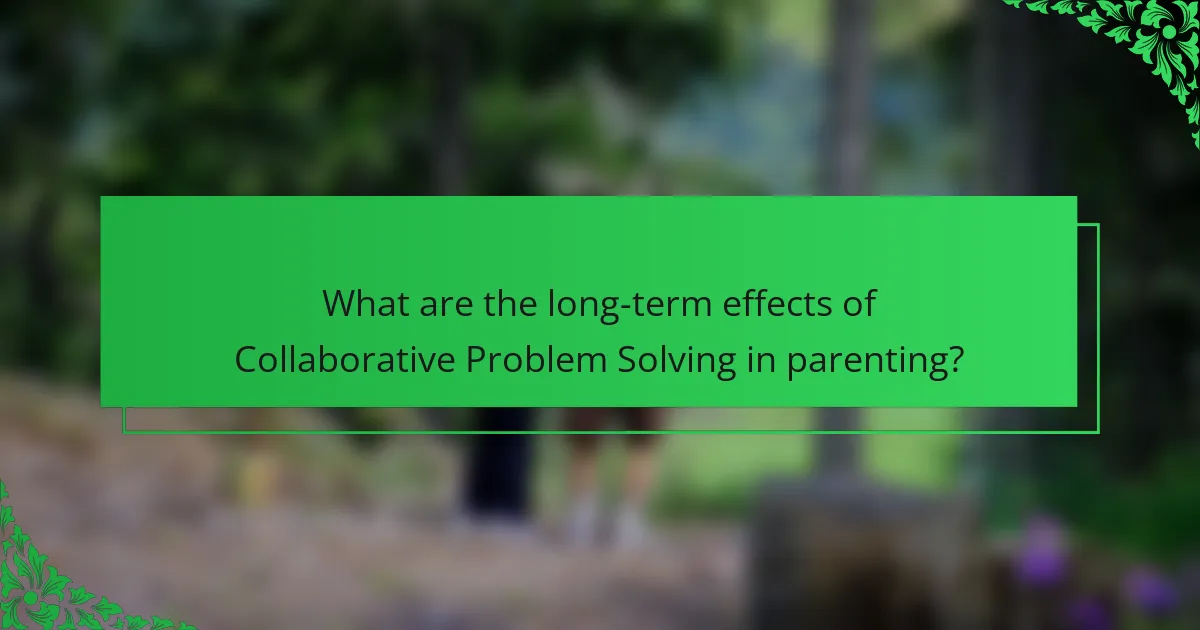
What are the long-term effects of Collaborative Problem Solving in parenting?
Collaborative Problem Solving (CPS) in parenting leads to improved emotional regulation in children. This approach fosters better communication skills over time. Parents and children develop mutual respect and understanding. Research indicates that children exposed to CPS exhibit fewer behavioral issues. They also show enhanced problem-solving abilities. Long-term engagement in CPS can strengthen parent-child relationships. Studies highlight reduced parental stress as a significant benefit. Overall, CPS contributes positively to family dynamics and child development.
How does Collaborative Problem Solving influence children’s behavior over time?
Collaborative Problem Solving (CPS) positively influences children’s behavior over time. CPS fosters essential skills such as communication, empathy, and conflict resolution. Children learn to express their feelings and needs constructively. This approach encourages them to work collaboratively with adults to find solutions. Research indicates that children engaged in CPS show improved emotional regulation. They also exhibit fewer behavioral issues in various settings. A study published in the journal “Child Development” found that CPS reduces aggressive behaviors in children. This method promotes long-term behavioral change by building trust and understanding. Overall, CPS creates a supportive environment conducive to positive behavioral development.
What evidence supports the effectiveness of this approach in various family dynamics?
Collaborative Problem Solving (CPS) has shown effectiveness across various family dynamics. Research indicates that CPS improves communication among family members. A study by Greene et al. (2016) found significant reductions in behavioral issues among children when parents used CPS techniques. Families reported enhanced cooperation and reduced conflict. Another study published in the Journal of Family Psychology highlighted positive outcomes in emotional regulation for children involved in CPS. These findings suggest that CPS fosters healthier family interactions and problem-solving skills.
What best practices can parents follow for successful Collaborative Problem Solving?
Parents should actively listen to their children during Collaborative Problem Solving. This practice fosters open communication and mutual respect. Parents must validate their child’s feelings and perspectives. Acknowledging emotions helps build trust in the relationship. Parents should encourage brainstorming solutions together. This collaborative approach promotes shared ownership of the problem. Setting clear expectations and boundaries is essential. Defining roles and responsibilities ensures accountability. Regularly reviewing the outcomes of solutions strengthens the problem-solving process. This reflection allows parents and children to learn from experiences. These best practices enhance the effectiveness of Collaborative Problem Solving.
How can parents create a supportive environment for problem-solving discussions?
Parents can create a supportive environment for problem-solving discussions by fostering open communication. They should encourage children to express their thoughts and feelings without fear of judgment. Active listening is essential; parents must show that they value their child’s input. Establishing a calm and distraction-free space promotes focus during discussions. Setting clear expectations for respectful dialogue helps maintain a constructive atmosphere. Additionally, parents can model problem-solving skills by sharing their own experiences. Research shows that children learn effective communication and collaboration skills when guided by supportive parents. This approach not only enhances problem-solving abilities but also strengthens parent-child relationships.
What role does consistency play in the effectiveness of Collaborative Problem Solving?
Consistency is crucial for the effectiveness of Collaborative Problem Solving. It establishes a reliable framework for communication and expectations. When parents consistently apply the principles of this approach, children feel secure and understood. This security fosters an environment conducive to open dialogue. Research indicates that consistent strategies lead to improved problem-solving skills in children. According to a study by Greene et al. (2016), consistency enhances trust and collaboration between parents and children. This trust is essential for effective problem resolution. Overall, consistency reinforces the collaborative process, making it more effective in achieving positive outcomes.
Collaborative Problem Solving (CPS) in parenting is a method that promotes teamwork between parents and children to address behavioral challenges through empathy, open communication, and mutual respect. This article explores the principles and strategies of CPS, highlighting its differences from traditional parenting approaches and its benefits, such as improved emotional regulation, problem-solving skills, and stronger parent-child relationships. Key components include establishing a collaborative relationship, defining problems together, and brainstorming solutions, while also addressing potential challenges and misconceptions. The article provides practical steps for parents to implement CPS effectively, ensuring a supportive environment for ongoing communication and conflict resolution.
